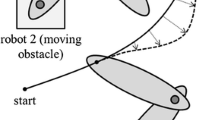Abstract
In highly flexible and complex handling systems the risk of collision of moving machine components is continuously increasing. When, for example, several robots share the same workspace and the environment in the workspace is changing due to the operation, the robot trajectories can no longer be planned in advance without the risk of collision. The objective of this paper is the collision-free motion planning of handling system manipulators from the start to the end position within a changing environment. For this purpose, the trajectories on the control system have to be planned during the operating time most efficiently depending on the current state of a varying environment. This paper describes a new approach for trajectory planning based on curve shortening flows combined with potential fields. The functional capability of the method will be demonstrated initially on a simple robot kinematics with two degrees of freedom.






Similar content being viewed by others
References
Kumar V, Zefran M, Ostrowski JP (1999) Motion planning and control of robots. In: Nof Y (ed) Handbook of industrial robots. Wiley, Chichester, pp 295–315
Latombe JC (1991) Robot motion planning. Kluwer, Dordrecht
Choset H et al (2005) Principles of robot motion. MIT-Press, Cambridge
LaValle SM (2006) Planning algorithms. Cambridge University Press, Cambridge
Hwang YK, Ahuja N (1992) Gross motion planning a survey. ACM Comput Surv 24:219–291
Brooks RA (1983) Solving the find-path problem by good representation of free space. IEEE Trans Syst Man Cybern 13(3):190–197
Yang DH, Hong SK (2007) A roadmap construction algorithm for mobile robot path planning using skeleton maps. Adv Robotics 21(1–2):51–63
Schwartz JT, Sharir M (1983) On the piano movers problem: 1. The case of two-dimensional rigid polygonal body moving admist polygon barriers. Comm Pure Appl Math 36:345–398
Khatib O (1986) Real time obstacle avoidance for manipulators and mobile robots. Int J Robotics Res 5(1):90–98
Koren Y, Borenstein J (1991) Potential field methods and their inherent limitations for mobile robot navigation. Proc IEEE Conf Robotics Autom 1398–1404
Laumond JP et al (1994) A motion planner for non-holonomic mobile robots. IEEE Trans Robotics Autom 10(5):577–590
Tominaga H, Bavarian B (1991) Solving the moving obstacle path planning problem using embedded variational methods. Proc 1991 IEEE Int Conf Robotics Autom 450–455
Brakke KA (1978) The motion of surface by its mean curvature. Princeton University Press, Princeton
Gage ME, Hamilton RS (1986) The heat equation shrinking convex plane curves. JDG 23:69–96
Angenent S (1991) Parabolic equations for curves on surfaces part II. Intersections, blow-up and generalized solutions. Ann Math 133(1):171–215
Kimmel R, Kiryati N, Bruckstein AM (1997) Analyzing and synthesizing images by evolving curves with the Osher-Sethian method. Int J Comput Vis 24(1):37–55
Smith SL, Broucke ME, Francis BA (2007) Curve shortening and the rendezvous problem for mobile autonomous robots. IEEE Trans Autom Control 52(6):1154–1159
Acknowledgments
The authors Konrad Groh and Sascha Röck would like to thank the German Research Foundation (DFG) for financial support of the project within the Cluster of Excellence in Simulation Technology (EXC 310/1) and the Graduate School of advanced Manufacturing and Engineering (GSaME) at the University of Stuttgart. We also appreciate very much that Alexander Verl, director of the Institute for Control Engineering of Machine Tools and Manufacturing Systems (ISW), strongly supported our work.
Author information
Authors and Affiliations
Corresponding author
Rights and permissions
About this article
Cite this article
Groh, K., Röck, S. A contribution to collision-free trajectory planning for handling systems in varying environments. Prod. Eng. Res. Devel. 4, 101–106 (2010). https://doi.org/10.1007/s11740-009-0202-0
Received:
Accepted:
Published:
Issue Date:
DOI: https://doi.org/10.1007/s11740-009-0202-0



